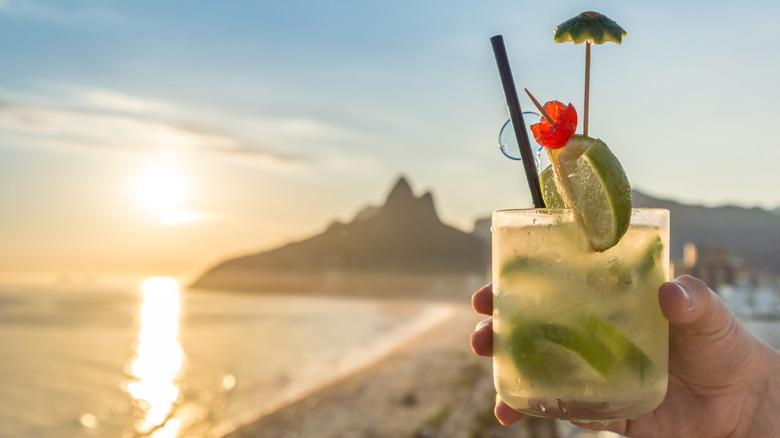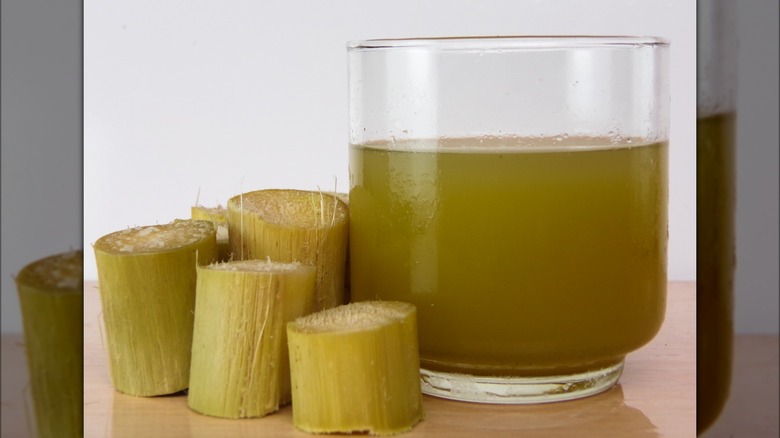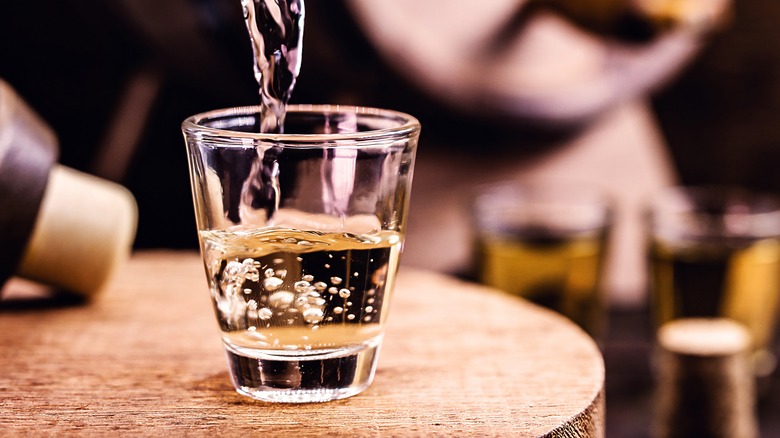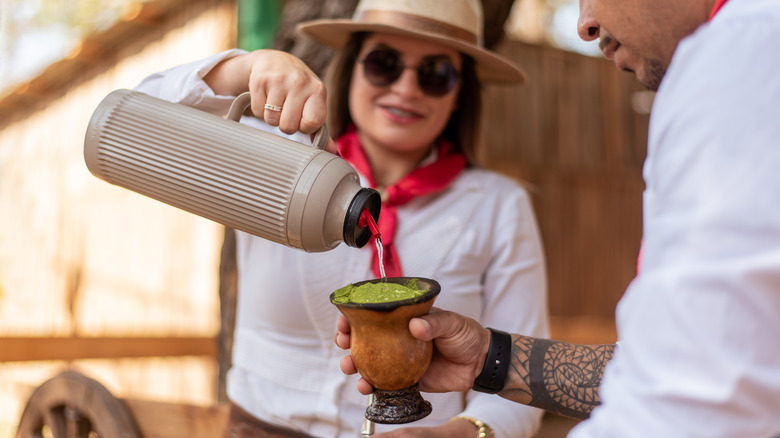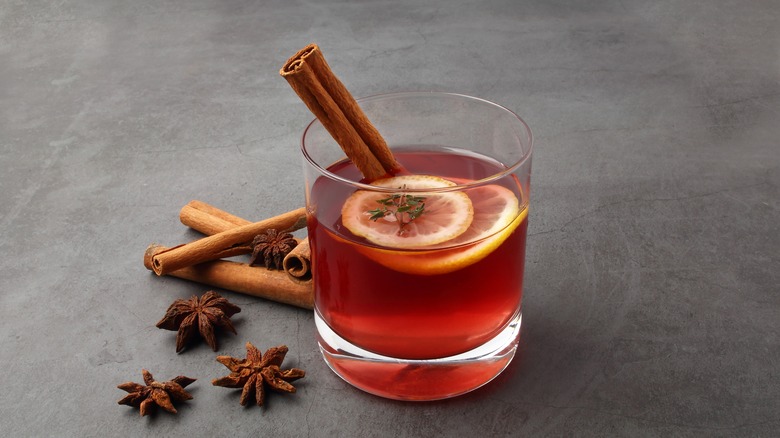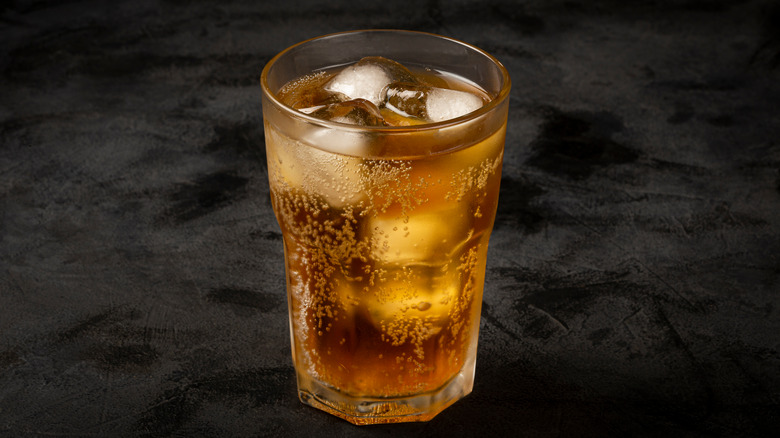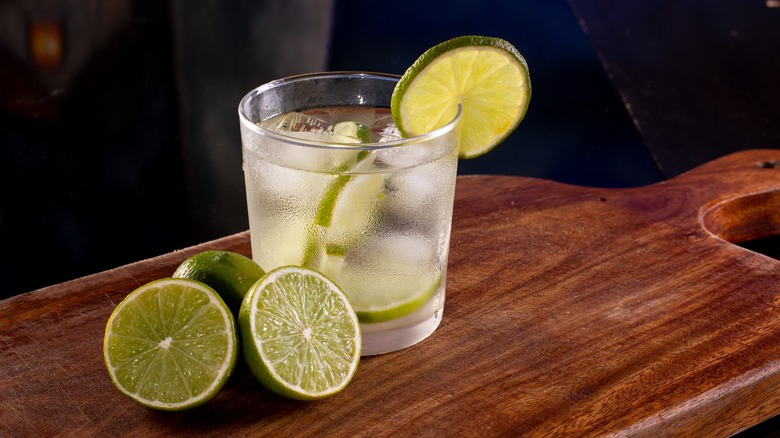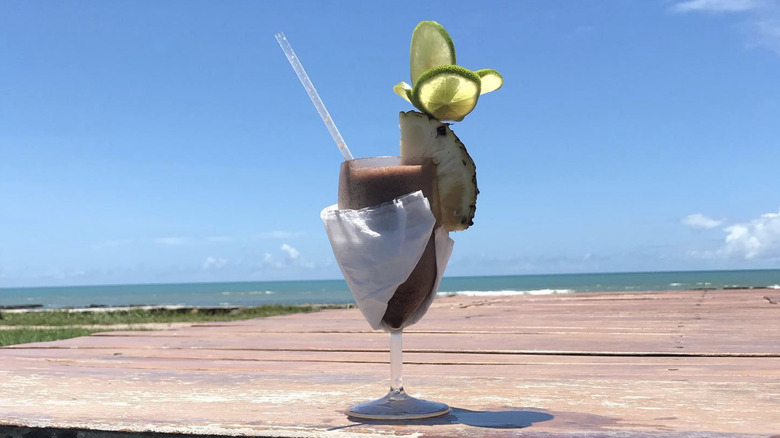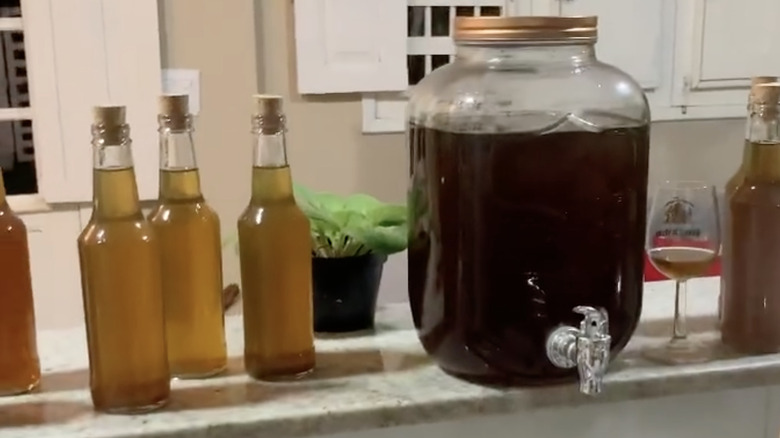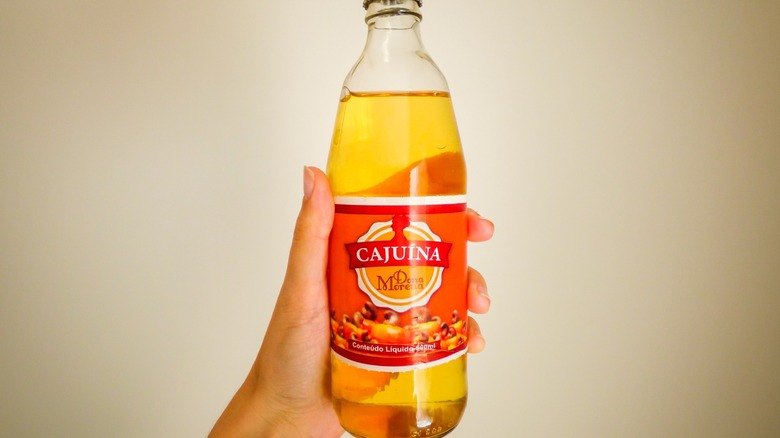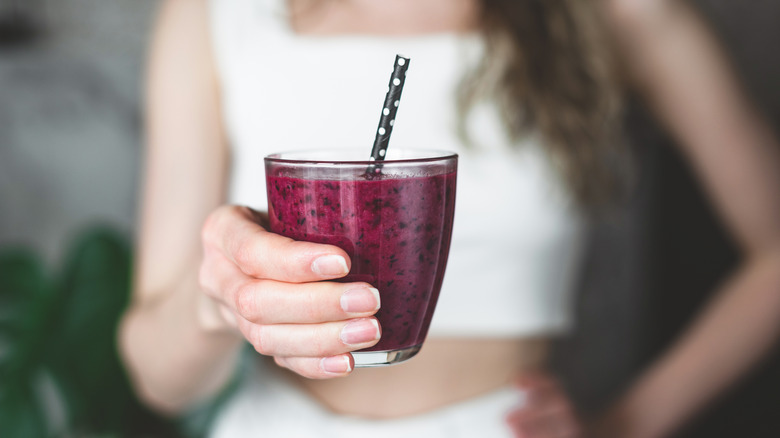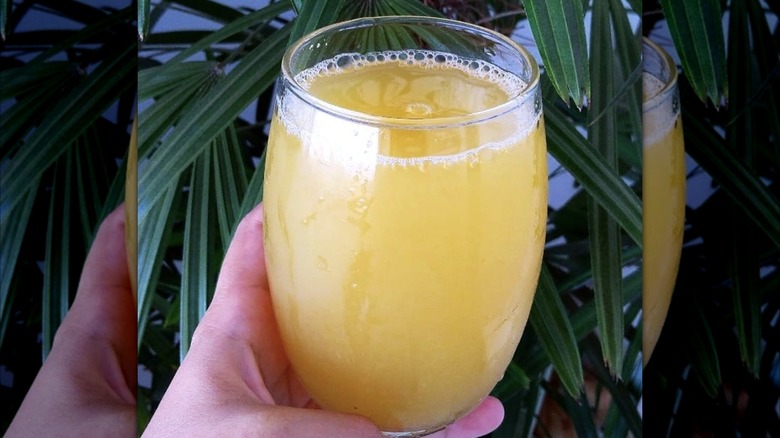12 Brazilian Drinks You Should Try At Least Once
If you're spending the day on Ipanema Beach in Rio de Janeiro, you'll likely notice vendors walking by selling all kinds of cold beverages to keep you pleasantly hydrated (and potentially buzzed) in the tropical heat. Of course, while iced tea, açaí smoothies, beer, and caipirinhas are often sold along Brazilian beaches, those aren't the only drinks found throughout the diverse cultural and natural landscapes of Brazil.
A blend of European, African, and indigenous populations, Brazil's national identity isn't remotely monolithic — and neither is the country's drink menu. From drinks made with native fruits like cashews and guaraná to a cocktail created by enslaved Africans, the story of Brazilian beverages is hardly boring.
For further insight into the South American nation's greatest drinks, we turned to the experts: Danielle Espindola, a Rio native and bar program director at the New York City-based Brazilian restaurant Berimbau; and Rafael Welbert, a Brazilian mixology expert and part owner of Pindorama (a luxury cachaça brand made in the state of Rio de Janeiro). If you're looking to sip on the best beverages Brazil has to offer, keep reading, as we discuss 13 Brazilian drinks you need to try at least once.
Caldo de cana
Considering most of the world's sugar comes from Brazil, it's only fitting the country also produces some fiercely sweet beverages. With its long sugar-producing history, sweetened beverages are practically part of the Brazilian DNA – and it doesn't get much sweeter than caldo de cana.
A drink made from crushed sugar cane, this juice is typically made by feeding peeled sugar cane stalks into a machine that crushes the cane between two wheels. This yields a greenish-yellow liquid that's often drunk ice cold alongside a piping hot pastel (or a Brazilian fried dough pocket). Interestingly, the process for making caldo de cana is the same first step used when making refined sugar.
If you're wondering what caldo de cana tastes like, the answer is not much. The drink doesn't have a strong aroma or flavor beyond its intensely saccharine profile and a hint of grassiness. Still, you're certain to get a sugar rush with caldo de cana, so buyer beware.
Cachaça
Mexico has tequila, Russia has vodka, Jamaica has rum, and Brazil has cachaça. Distilled from sugar-fermented juice — it's no surprise Brazil's signature liquor is made of sugar cane — this delicately sweet and slightly grassy spirit is consumed all over Brazil. Of course, just like the country itself, cachaça has a complex history.
As Rafael Welbert explained to Tasting Table, in colonial times, cachaça was largely "consumed by the slaves of the sugar mills, as they worked in the mills and knew how to extract sugar." Since the upper classes in Brazil mostly drank wine during that time, cachaça "lacked status because it was consumed by the slaves themselves and poor whites."
Despite its history as a lower-class alcohol, cachaça has had a welcome resurgence in the 21st century. Luxury cachaça brands like Pindorama have popped up across Brazil and the liquor can be found at bars around the world. Simply put, you should consider swapping rum with cachaça in your next tropical drink – and thank us later.
Chimarrão (yerba mate)
In the Brazilian state of Rio Grande do Sul, chimarrão is everywhere. You'll see people drinking it in the park, at the beach, at home, and just about anywhere else you can sit down with your friends and pass the hot beverage around. Known in other South American countries as yerba mate, the drink is also associated with Argentina, Paraguay, and Uruguay, where the plant grows naturally.
The fascinating history of yerba mate goes back to the time before Brazil was even a country. The yerba mate plant is native to subtropical South America, after all, and was made into a tea that was drunk well before the arrival of European settlers.
Over time, the consumption method hasn't changed much. Today, chimarrão is prepared by putting a scoop of toasted, ground yerba mate leaves into a gourd known as a cuia and sipping it through a metal straw with a filtered tip called a bomba. Yerba mate tastes grassy, earthy, and slightly bitter, and since the leaves are naturally caffeinated, you should feel a little energy boost as you sip it.
Quentão
If you live in the Northern Hemisphere, it's hard to imagine wanting a warm drink in the middle of June. Yet in Brazil, June marks the beginning of winter, meaning it's the perfect time to enjoy the traditional Brazilian hot cocktail called quentão.
"Quentão is a classic beverage with cachaça, wine, fruits, and spices," Rafael Welbert told us. The drink is a staple at Festa Juninas, which are festivals held across the country in June to celebrate rural lifestyles with music, dance, food, and (obviously) drinks. Furthermore, according to Welbert, "nothing is more common at this time of year than drinking quentão to warm up" (other than dancing, that is). The spices typically added to quentão include winter-friendly items like ginger, cloves, cinnamon, orange, and star anise, which pair well with the slightly sweet and bold taste of cachaça.
Though quentão's origins are unclear, Danielle Espindola stated, "It's believed it was first invented in Minas Gerais state, where it gets very cold in the winter." In short, quentão is essentially Brazil's take on a classic cozy mulled wine recipe, and the addition of cachaça gives it a distinctly Brazilian flavor profile you don't want to miss.
Guaraná
Wherever you find soda in Brazil, you'll likely find guaraná, too. Named for the Amazonian fruit that flavors the bubbly beverage, the most popular brand of guaraná is Antarctica (which is to guaraná what Coke is to cola). Antarctica comes in a signature dark green bottle and is best when served ice cold.
Now, the taste of guaraná — fruity and a little sour, with a touch of bitterness — is hard to pin down. However, since guaraná extract is used in Monster energy drinks (it contains more caffeine than coffee), if you've had one of those? You've got an idea of what it tastes like.
The history of guaraná goes back hundreds of years when Jesuit missionaries observed members of the Sateré-Mawé tribe drinking a guaraná-infused liquid to cure headaches and other ailments. In fact, some research suggests ingesting guaraná may provide health benefits beyond a simple energy boost. It's not necessarily common in many U.S. locations, but you can order guaraná online or find it at specialty Brazilian grocery stores.
Caipirinha
One of the best-known Brazilian drinks outside the country, the caipirinha is Brazil's national cocktail. The caipirinha is made with the nation's historic spirit, cachaça, which is then muddled with limes and granulated sugar. You can get a caipirinha practically anywhere in Brazil that has cocktails, and they taste particularly delicious from a beach chair nestled in the sand overlooking the Atlantic ocean.
Now, although lime is considered the original caipirinha flavor, common alternatives include pineapple, strawberry, and passion fruit, which gives the drink a distinctly tropical taste. Then again, a caipirinha made with lime has just the right amount of sweetness and acidity to round out the alcoholic bite of cachaça.
Additionally, according to Danielle Espindola, "The cocktail should be shaken and poured with its own 'dirty ice'." If you're not a fan of cachaça, you can always order a caipiroska and swap in vodka instead. The popularity of caipirinhas has exploded from its original use in festivities among slaves and can be found at bars around the world in the 2020s.
Capeta
If you've got a sweet tooth and a hankering for booze, it's time you try a capeta (which translates to "devil" in Portuguese). Like so many other Brazilian cocktails, this one starts with the country's crown jewel of liquor: cachaça. Throw it in a blender with condensed milk, ice, guaraná syrup or powder, and a healthy dash of cinnamon, and voila! You've got yourself a devilishly delicious frozen cocktail.
But don't get too attached to those ingredients. After all, capeta can be made in many different ways depending on who's bartending. Possible additional ingredients include pineapple, chocolate milk, and vodka. Regardless of the specific ingredients, you can be sure your capeta will be sweet, cold, and boozier than it tastes.
The capeta rose to fame during the 1980s and '90s in Bahia — a state in Northeastern Brazil known for its rich history and colorful carnival festivities. The capeta may remain a regional beverage in the eyes of some, but the frozen drink is a clear hit on the beaches of Brazil during the summertime.
Licor de jenipapo
Brazil's Amazon region is home to the world's most biodiverse ecosystem – including a huge variety of fruits you've probably never heard of. One of these fruits, in particular, is the jenipapo, which is famous for a liquor infused with its flavor called licor de jenipapo.
When ripe, a jenipapo is about the size of a tennis ball. It has a unique, tangy aroma and a slightly sour undertone vaguely reminiscent of a passion fruit. Boiling jenipapo fruits with sugar neutralizes the more astringent taste elements and leaves you with a pulpy mass of sweet liquid. You then pass this through a cheesecloth to produce a brown-tinged syrup.
Finally, this liquid is mixed with cachaça to create licor de jenipapo. In Brazil's northeast region, licor de jenipapo is traditionally consumed as an aperitif after mealtime. Then again, if the opportunity arises? You shouldn't hesitate to try this Brazilian drink at any time of day.
Cajuína
While you may be used to the toasty, buttery taste of cashew nuts, the fruit of the cashew tree has a lot to offer, as well. It has a distinctly sweet, acidic, tropical flavor that's enjoyed in desserts and drinks all over Brazil — including cajuína. Named after the cashew fruit ("cajú" in Portuguese), this drink is a non-alcoholic beverage made from cashew fruit. The simple juice is popular in Brazil's northeast region, where the cashew tree's native habitat resides.
Cajuína is made by crushing or blending cashew fruits into a thick liquid and then using a precipitation agent (usually gelatin powder) to separate the clarified juice from the bitter tannins. The juice is then heated and bottled.
Although it's often made at home, commercially produced cajuína is available in stores throughout northeastern Brazil. Additionally, Cajuína's naturally high concentration of sugar and electrolytes means it has a similar effect on the human body as sports drinks like Gatorade, according to a 2024 study published in PubMed.
Mate gelado
If you're a regular on the beaches of Rio de Janeiro, you know the best way to quench your thirst on a hot day is with an icy glass of mate gelado. This slightly bitter iced tea is made with yerba mate, so it's got a nice zing of caffeine. Plus, it's often sweetened with sugar and comes in lemon and passion fruit flavors. More than that, you can't miss the mate vendors on the beach. They usually wear bright orange outfits and have a big metal barrel of mate hanging from each shoulder.
Although yerba mate is traditionally consumed hot in southern Brazil, the iced version made its way up the coast to Rio de Janeiro in the 1950s. Mate gelado is so integral to the beach culture in Rio that it was designated a part of its cultural heritage by the city government in 2012.
Pro tip: You can ask mate vendors on the beach to mix flavors. If you don't like your drinks too sugary, you can get your mate unsweetened with a splash of passion fruit or lemon mate, as well. It also makes for a flavorful addition to sweeten iced tea without plain sugar.
Açaí smoothie
Of all the tropical fruits to come out of Brazil, açaí may be the most famous. If you pay attention to food trends, you know that açaí started to become available in the U.S. in the early 2000s, and its popularity has remained consistently high since then. Since most of the world's açaí comes from Brazil, it's no wonder Brazilians know one of the best ways to enjoy this Amazonian berry is blended ice cold in a smoothie.
Eaten by themselves, açaí berries are quite bitter and earthy. But when you combine them with other fruits like bananas and strawberries (along with a dash of honey), you end up with a beautifully purple smoothie — one with the perfect amount of fruity sweetness.
Of course, açaí isn't just famous for being delicious. These little berries contain more antioxidants than blueberries, raspberries, or cranberries, which means they may help prevent cell damage in your body. In other words, don't wait any longer to try this famous Brazilian drink.
Aluá
If you're looking for aluá in a store, you're out of luck: This traditional Brazilian beverage is typically only made at home. Recipes for aluá vary from region to region, though one popular take starts with pineapple rinds. The rinds are soaked in water for at least 24 hours so they have a chance to ferment, which lends aluá its characteristically funky, slightly alcoholic flavor.
Another common way to make aluá is with corn kernels that have been soaked and blended. This gives the drink a uniquely earthy and starchy taste that's cut with other flavors like ginger and spices. While it's not typically super boozy, aluá does contain some alcohol (it's a natural result of the fermentation process, after all).
Additionally, aluá is typically consumed at Festa Juninas, or festivals that take place across Brazil in June. With that in mind, if you've got some leftover corn or pineapple when May ends? You can make your own aluá and have a mini Festa Junina at home.
